In-depth #5
For my last post, I made cream puffs, but rather than filling them with cream, I filled them with ice cream. For this post, I made a new French dessert that included the pastry cream filling that was supposed to go in the cream puffs. The dessert is called Mille-Feuille (pronouced mill-foy).
Mille-Feuille, translated into “a thousand sheets/leaves” is a dessert layered with puff pastry and pastry cream. It is often topped with icing on top in a chevron pattern. I decided to make this dessert as I wanted to learn how to make pastry cream I did not have time to learn last time. Its main focus is on the pastry cream, so this dessert felt like the appropriate “test” of how well I could make pastry cream. I decided to use frozen puff pastry for this, which may seem low effort since half of the dessert is the puff pastry, however, I did not have the correct equipment, and the dessert already took long enough without making the puff pastry from scratch. It took over three hours to make in total.
I started off this recipe by making the pastry cream. It needed to chill so that the cream could develop flavor and thicken for at least two hours. It is very traditional to use a vanilla bean when making pastry cream, however, it is very expensive. Since there was a big chance that something could go wrong, I did not want to risk wasting a vanilla bean. An alternative would be vanilla bean paste or extract, however, I chose extract since it was the only vanilla bean product I could find nearby. I made sure to use real vanilla extract rather than artificial as the vanilla flavor was the main part of the cream. I found the process of making this cream quite similar to making the creme brulee. They share the similarity of being an egg yolk base, along with tempering required. The only main difference that I noticed was the corn starch that was added to the pastry cream. I combined my vanilla and milk, along with sugar, corn starch, and egg yolks in a separate bowl. To temper, the mixture means to slowly bring up the temperature of a mixture by whisking constantly and adding hot liquid in small increments. The point of tempering is to prevent the egg yolks from cooking improperly, which forms clumps. The texture of pastry cream is an essential aspect so having curdled eggs would have ruined it.
Next was the puff pastry. Puff pastry is a common type of pastry used for many different foods, both savory and sweet. In this case, I was using puff pastry for a sweet dessert. Baking the puff pastry was the most difficult part, despite the fact that it was not even made from scratch. First, I had to roll the puff pastry. Getting it to roll into a large, thin sheet took quite a while. It was difficult to get it to an even thickness and I could not roll out the pastry with even pressure or even at the same time. I had to eye-ball the thickness and hoped that it would work. Next, was the most meticulous part. I had to use a food-safe ruler to measure out the pastry. Aesthetics are very important for this dessert, so getting the same, or a close size for each sheet of puff pastry was crucial to the looks of the dessert. After I had measured and cut out the pastry, I placed it onto a parchment-lined baking sheet, and then placed a second one on top so that the puff pastry would stay flat while baking. Puff pastry is called puff pastry because it puffs up while cooking, which is something that I wanted to avoid, as the pastry would then become too thick.
This was actually the first time that I used the oven thermometer that I bought a while ago. What I figured out by using the oven thermometer was that my oven was mostly fine. It would reach the temperature that it was supposed to, but it did not retain the heat very well. My oven took about twenty minutes to fully reach the temperature that I wanted, which is quite typical. Like almost all ovens, opening the oven door may result in a drop in temperature in the oven, as the air outside of the oven was not the same as the temperature inside. The problem with my oven was that it would lose a lot of its temperature, and then take very long to heat back up. I noticed that it dropped about 25 degrees, which is a big difference. Unfortunately, I could not just set my oven temperature to 25 degrees higher each time, as the temperature would eventually surpass the desired temperature, so I had to try my best to keep a close eye by preheating the oven to 25 degrees higher, and then lower the oven temperature to around how much actually dropped.
Once I figured out everything with my oven, I put my puff pastry in the oven. From here, the process began to go down. I noticed that based on the time it took to fully cook, I had cut the pastry too thick. Once I took my pastry out of the oven, it turned out to have overcooked because when it cooled, it got a little too hard.
Since I had a lot of time between putting in my puff pastry into the oven and taking it out, I decided to set up the rest of the dessert. Something that went very well was making the icing. I had never made royal icing before, but it was very simple and only required two ingredients. Icing is based on the look rather than measuring it out to perfection like most other baked goods. There is a general amount to follow, but it is not completely accurate, so getting the icing to the thickness that I got was based on guessing. I made the icing and then separated a little bit to another bowl and added cocoa powder to make it chocolate. Then I transferred the chocolate icing into a piping bag so that it was ready to use. While the puff pastry was in the oven, I also lightened up the pastry cream. Since it was a little thick to pipe, I added whipped cream, which helped balance out the flavor and fix the consistency.
Once everything was done, I began to assemble. One more thing that I had done right before was cut the puff pastry to a more equal shape like the other sheets of puff pastry. Starting with the top piece of puff pastry, I spread some regular icing on top and then used the piping bag with the chocolate icing to drizzle some horizontal lines back and forth. Then, I used a toothpick to drag vertical lines to create the chevron pattern. I actually did not have more than one piping bag, and I needed one for my pastry cream, so I had to take the chocolate icing out, wash the bag, and add in my pastry cream. I also switched out the tip to a much bigger one so that piping the cream would not take such a long time. I added a sheet of puff pastry (without the icing), piped pastry cream, added another blank sheet, another layer of pastry cream, and the top sheet of puff pastry with the design on top.
Overall, I did not find anything to be particularly difficult, however, I did find this recipe to be quite time-consuming.
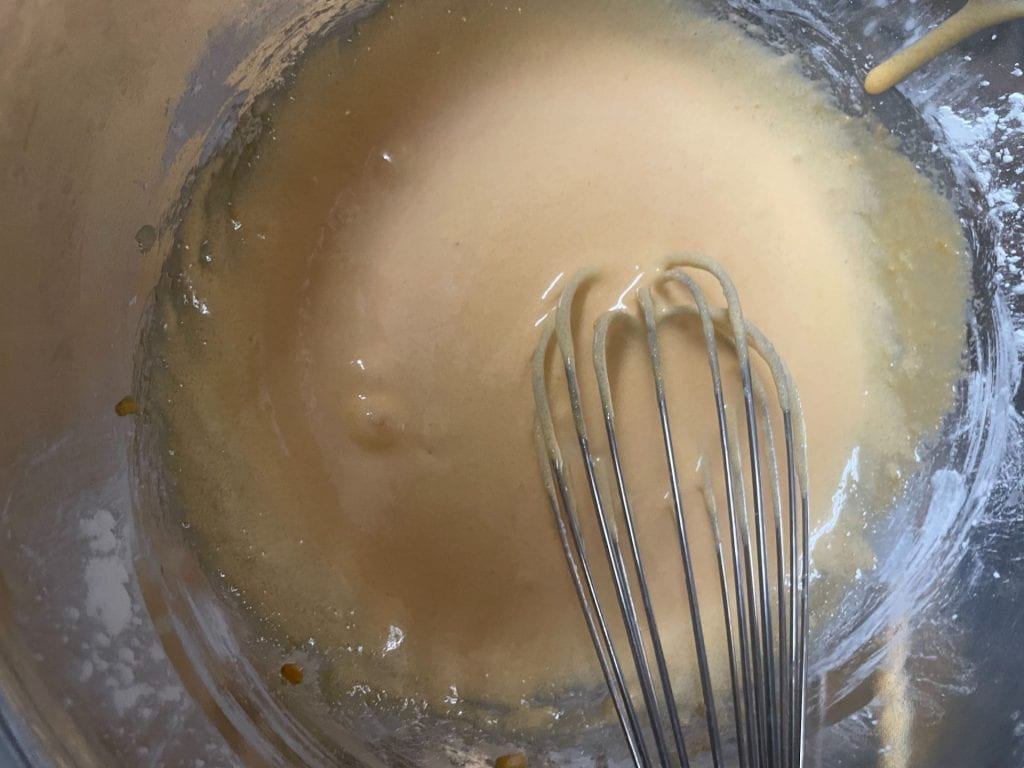 Mixing together ingredients to make the pastry cream.
Mixing together ingredients to make the pastry cream.
 Heating up the ingredients on a pot.
Heating up the ingredients on a pot.
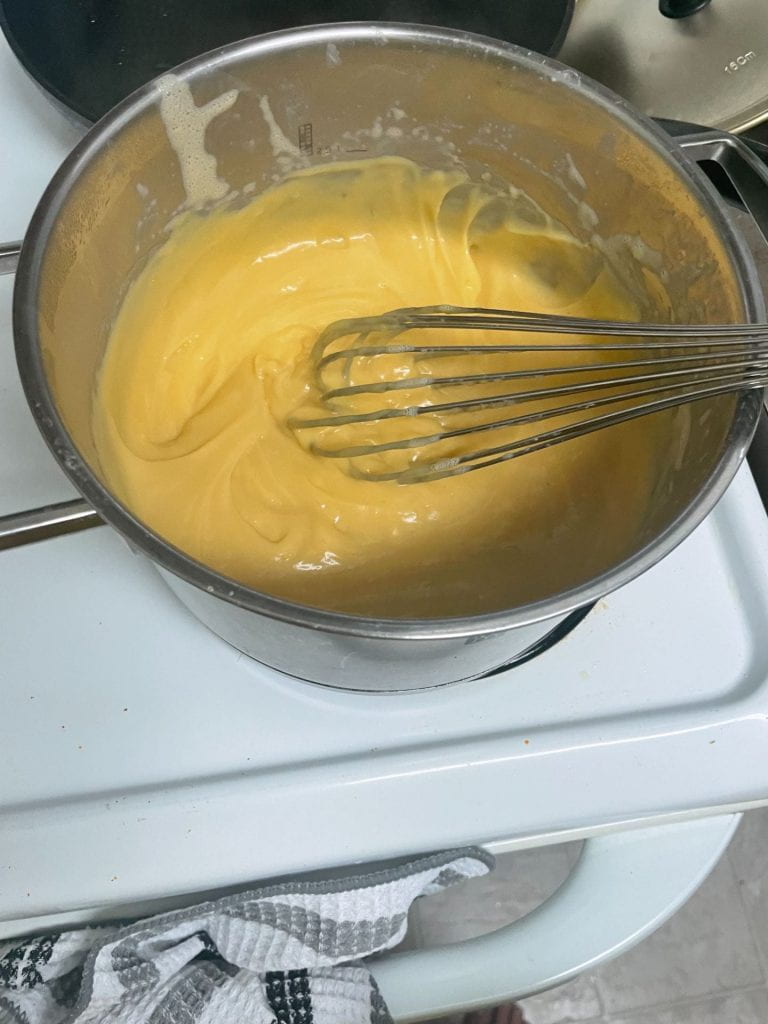 Pastry cream fully cooked and combined, ready to chill.
Pastry cream fully cooked and combined, ready to chill.
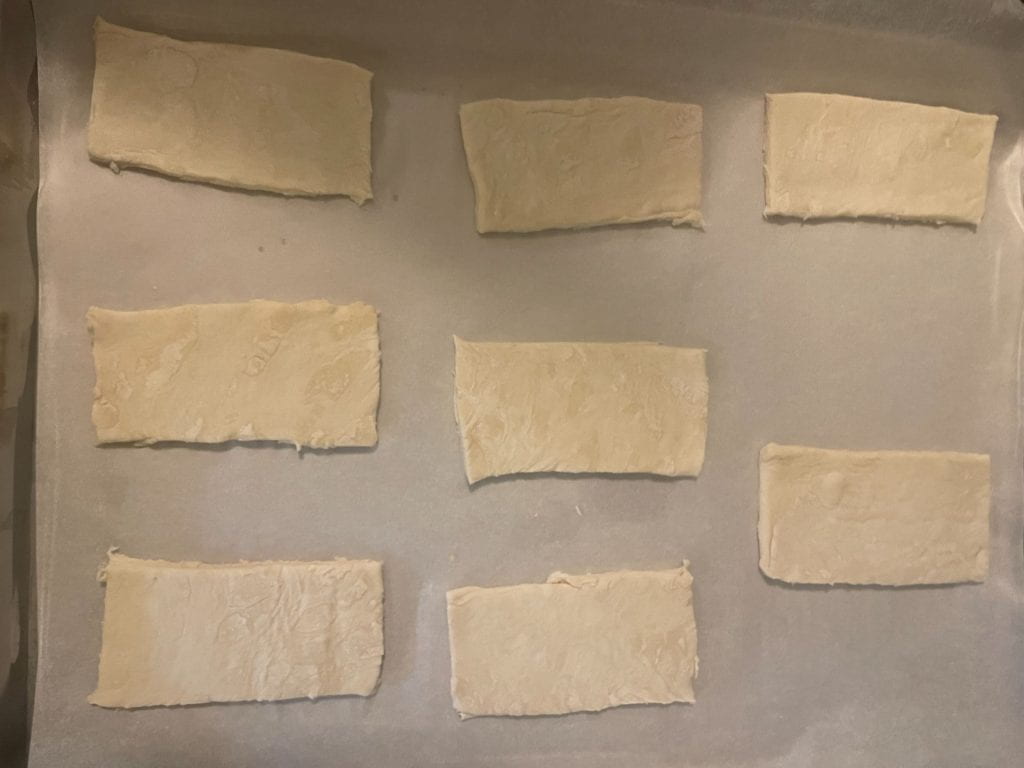 Sheets of puff pastry cut and set on a baking sheet.
Sheets of puff pastry cut and set on a baking sheet.
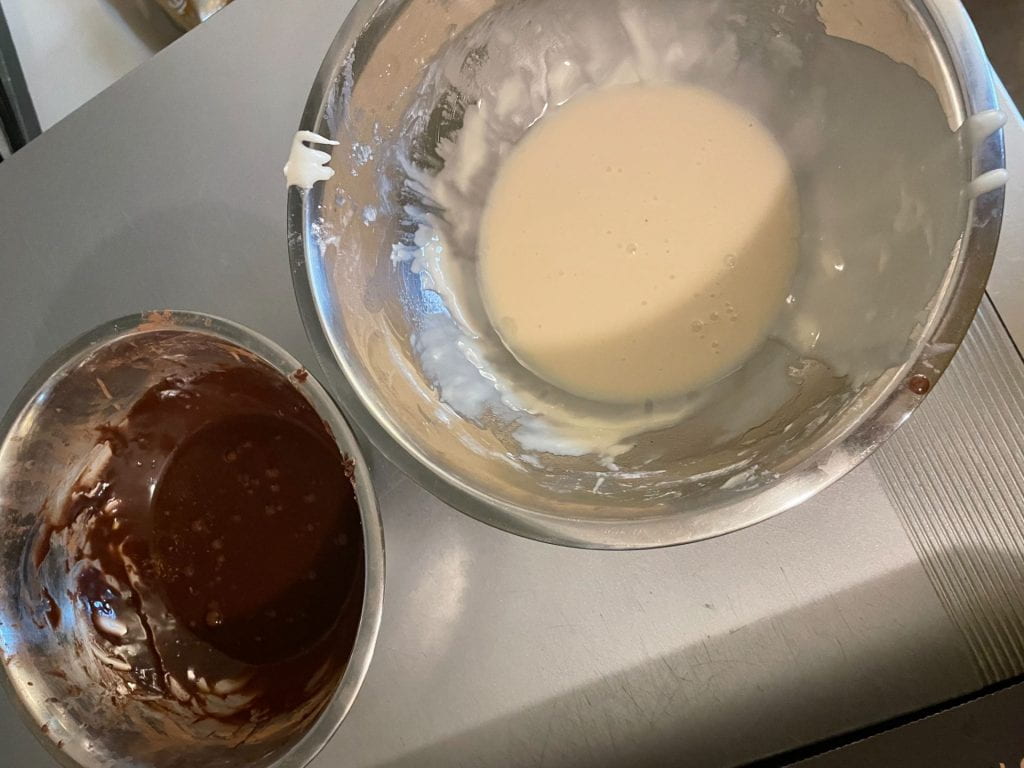 Two different icings prepared to pipe onto puff pastry.
Two different icings prepared to pipe onto puff pastry.
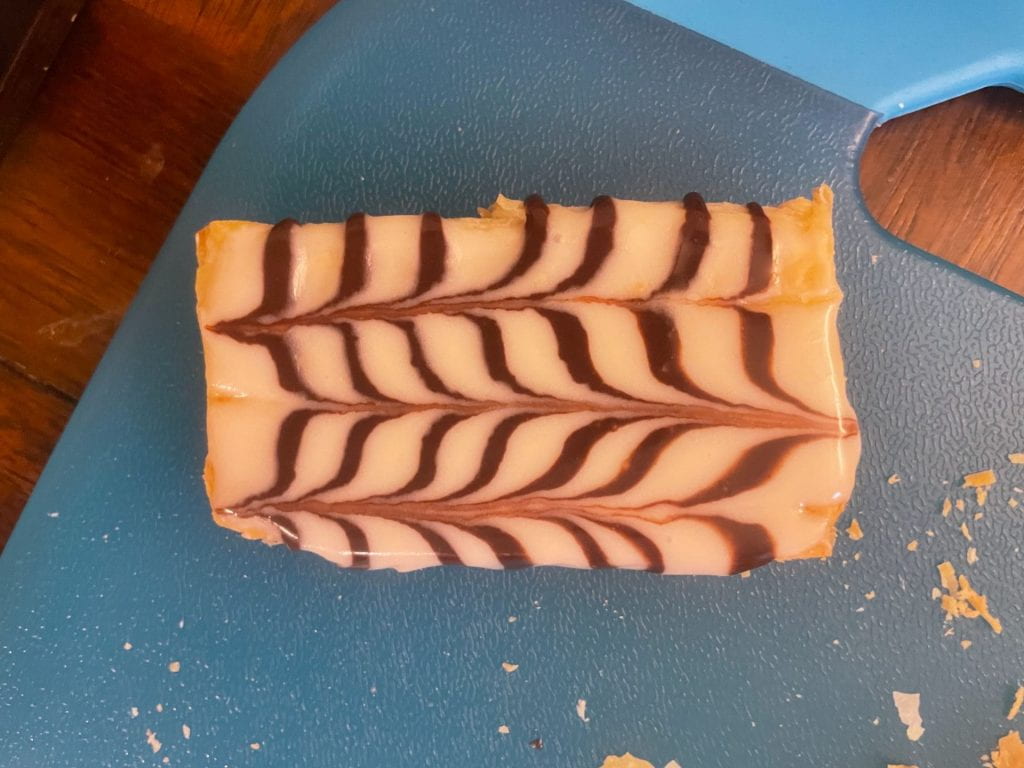 Design piped onto the top pieces of puff pastry.
Design piped onto the top pieces of puff pastry.
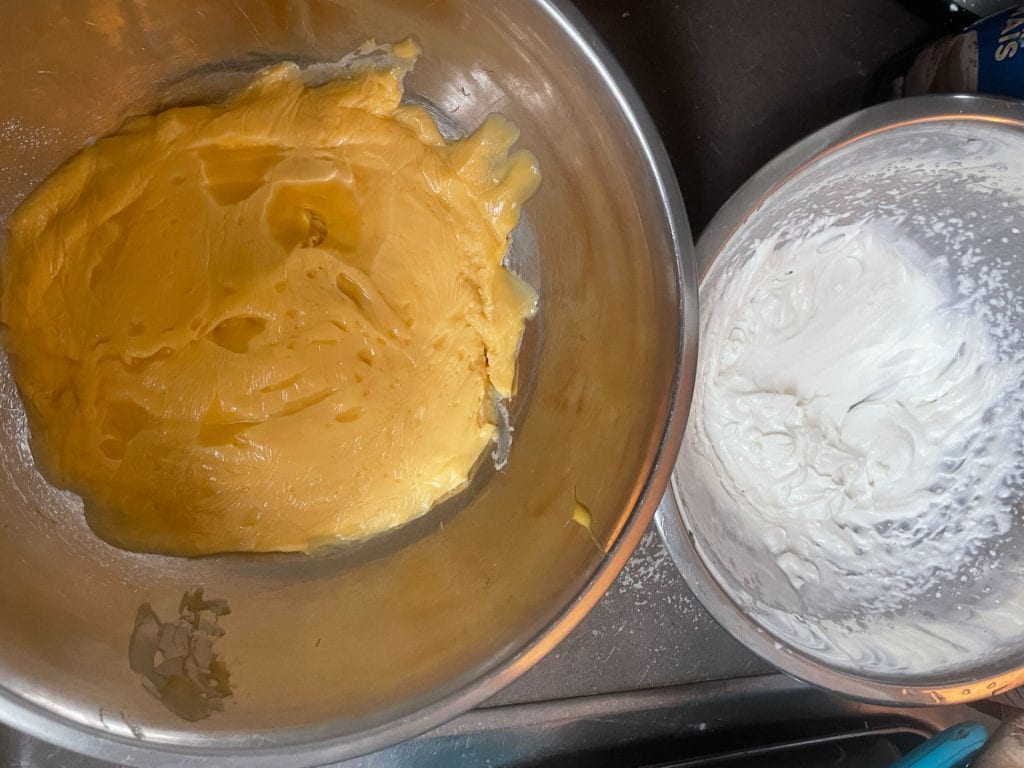 Whipped cream and chilled pastry cream, ready to combine to lighten up.
Whipped cream and chilled pastry cream, ready to combine to lighten up.
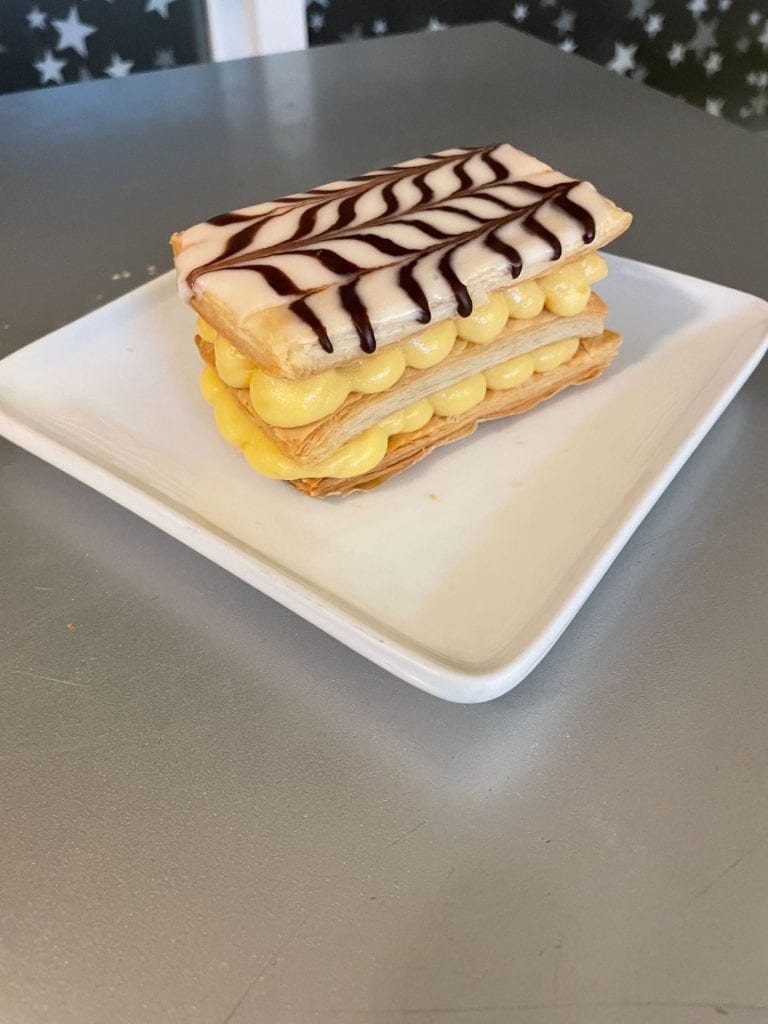 Finished product, fully assembled.
Finished product, fully assembled.
Mille-Feuille
The cookbook from 1651 called Le Cuisinier François was the first time the Mille-Feuille was featured. It was later then improved by chef Marie-Antoine Carême. Another chef named Adolphe Seugnot claimed the Mille-Feuille as his own recipe and some even credit him for the creation of Mille-Feuille despite the evidence that proves otherwise. Nothing else is known about the Mille-Feuille’s origin and what it was like in the earlier centuries.
Some call Mille-Feuille, Napoleon, however, the main difference is the filling in Napolean, which is typically almond cream rather than the vanilla cream featured in Mille-Feuille.
Questions
1. What kinds of learning opportunities does the mentor provide to expose you to new learning?
The learning opportunities that my mentor shares with me helps me to develop and gain knowledge about cooking with new techniques, and in an environment outside of a home kitchen. My mentor will often assign me to cook the foods I cook for in-depth in an allotted time, and even just practice cooking with speed outside of French food. Knowing how to cook with efficiency allows the product of what I cook to be completed in a shorter amount of time, and sometimes with better taste. Cooking with speed can preserve freshness as the time between cooking and eating is minimal. My mentor will also often suggest different foods that I can make for future meetings that feature new techniques that I have not yet learned. If I decide to choose my own recipe, he encourages me to find recipes that have new ideas that I have not yet learned about so that my experience with cooking French food is always new and refreshing.
2. What kinds of learning opportunities exist to reinforce new learning?
Keeping track of the time it takes to cook is a small detail that opens up a new opportunity to learn about efficiency and improvement. I have been introduced to reflecting on the process of cooking with my mentor, which helps because I have a second perspective that can provide input on how I did, rather than just relying on my self-awareness. Going back to see where I could have sped up and avoided doing helps to apply new strategies to future cooking sessions as I become more conscious of my movements and I have more thought about what I make.
My mentor will also often tell me to find and name the different techniques that are featured in the recipes that I follow. This allows me to keep refreshing my memory and understand the applications of the different techniques that I learn. Since I have learned quite a lot of techniques by now, remembering the use for each and understanding why they are used can become difficult so having a recipe that applies the techniques to make the food help.
3. What kinds of opportunities exist that might accelerate learning?
The opportunity to meet up in person to discuss the foods I cook and actually cook with my mentor really helps to improve and accelerate my learning. Having a hands-on experience is the best way for me to learn as it allows me to fully understand my ability to cook/bake, instead of making assessments about my ability based on past cooking. French food is quite meticulous as well so understanding my making mistakes and learning that way helps me to avoid the same/similar mistakes and quickly improve.
4. When you get together what do you talk about?
When meeting up, my mentor and I normally get straight into discussing what I will do and talk about the process while cooking. While I try to create conversation outside of just in-depth cooking, due to cooking taking quite a long time, there is not much time for small talk. For the most part, the conversations we’ll have are about the mistakes I made and trying to figure out and think about what happened when cooking, and why. Sometimes, we will also talk about what we are planning to do for upcoming meetings, and lately, we have been discussing my plans for in-depth night.
5. What is going particularly well in your mentoring relationship right now?
Something that is going well in my mentoring relationship is being able to contact my mentor outside of the meetings that we have. Although I try to ask all my questions and talk with my mentor during my meetings, there are times when I am cooking outside of the meetings for fun, and during those times, I can ask for advice and feedback that I can apply when cooking French food for my blog posts. While the feedback is not exclusive to French cooking, I still find it very helpful that I can reach out to my mentor about cooking in general as my main goal with in-depth was to focus on learning how to cook anything and everything.
6. What are you learning about one another?
Since my mentor and I do not converse about topics outside of in-depth, it has been harder to learn about him. Everything that I have been learning about my mentor has been based on my own observations about his personality and what he is like, which means I have not really learned about his personal life at all. One thing that I learned was about his passion for cooking. I learned that he doesn’t necessarily enjoy cooking, and views cooking as something that he does only as a job. Our independent views about cooking can sometimes conflict with my experience as it can cause disagreements about my ambitions and plans, however it has not been a significant problem with my learning.